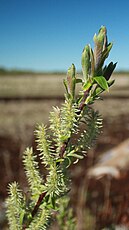
Salix caprea, known as goat willow, pussy willow or great sallow, is a common species of willow native to Europe and western and central Asia.

Salix purpurea, the purple willow, purpleosier willow, or purple osier, is a species of willow native to most of Europe and western Asia north to the British Isles, Poland, and the Baltic States.

Salix × fragilis, with the common names crack willow and brittle willow, is a hybrid species of willow native to Europe and Western Asia. It is native to riparian habitats, usually found growing beside rivers and streams, and in marshes and water meadow channels. It is a hybrid between Salix euxina and Salix alba, and is very variable, with forms linking both parents.

Pussy willow is a name given to many of the smaller species of the genus Salix when their furry catkins are young in early spring. These species include :

Salix amygdaloides, the almond leaf willow or peach leaf willow, is a species of willow native to central North America east of the Cascade Range. It can be found in southern Canada and the United States—from western British Columbia to Quebec, Idaho, Montana and Arizona to eastern Kentucky. As of 2022, it is presumed extirpated from the state of Kentucky.
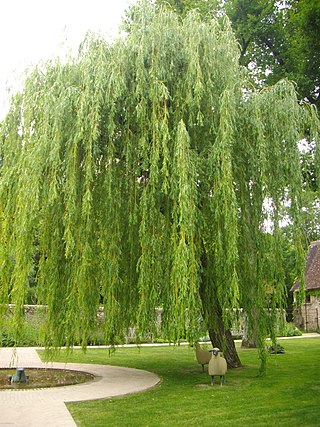
Salix babylonica is a species of willow native to dry areas of northern China, but cultivated for millennia elsewhere in Asia, being traded along the Silk Road to southwest Asia and Europe.

Salix pentandra, the bay willow, is a species of willow native to northern Europe and northern Asia. The scientific name refers to the male flowers having five stamens. The English name derives from the resemblance of the leaves to those of the bay laurel; other common names include bay-leaved willow and laurel willow. Its glossy leaves make it more decorative than many other willows, so it is often planted as an ornamental tree.

Salix cinerea is a species of willow native to Europe and western Asia.
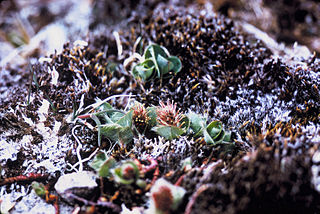
Salix arctica, the Arctic willow, is a tiny creeping willow. It is adapted to survive in Arctic conditions, specifically tundras.

Salix integra is a species of willow native to north-eastern China, Japan, Korea and the far south-eastern Russia.
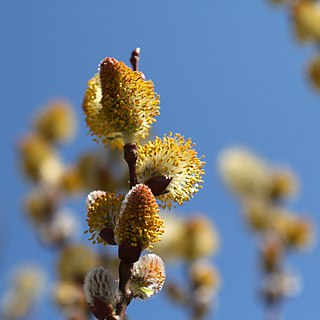
Salix gracilistyla is a species of willow native to Japan, Korea and China known in English as the rose-gold pussy willow.

Salix lucida, the shining willow, Pacific willow, red willow, or whiplash willow, is a species of willow native to northern and western North America, occurring in wetland habitats. It is the largest willow found in British Columbia.

Salix scouleriana is a species of willow native to northwestern North America. Other names occasionally used include fire willow, Nuttall willow, mountain willow, and black willow.
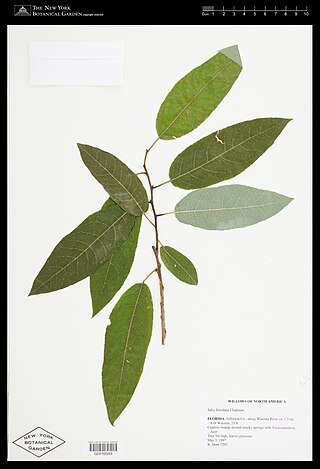
Salix floridana, the Florida willow, is a species of willow in the family Salicaceae. It is native to the southeastern United States in northern Florida and southwestern Georgia.
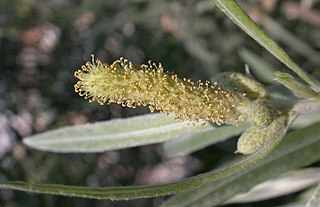
Salix exigua is a species of willow native to most of North America except for the southeast and far north, occurring from Alaska east to New Brunswick, and south to northern Mexico. It is considered a threatened species in Massachusetts while in Connecticut, Maryland, and New Hampshire it is considered endangered.

Salix triandra, with the common names almond willow, almond-leaved willow or black maul willow, is a species of willow native to Europe and Western and Central Asia. It is found from south-eastern England east to Lake Baikal, and south to Spain and the Mediterranean east to the Caucasus, and the Alborz Mountains. It usually grows in riparian habitats, on river and stream banks, and in wetlands.

Salix acutifolia, also known as Siberian violet-willow, long-leaved violet willow or sharp-leaf willow, is a species of flowering plant in the family Salicaceae, native to Russia and eastern Asia. It is a spreading, deciduous shrub or tree, growing to 10 m (33 ft) tall by 12 m (39 ft) wide. The young shoots are deep purple with a white bloom. The leaves are narrow, up to 10 cm (4 in) long. The catkins are produced in early spring, before the leaves. Older bark has a fine, netted pattern.
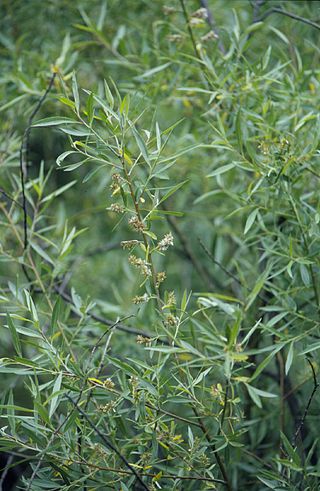
Salix geyeriana is a species of willow known by the common names Geyer's willow, Geyer willow and silver willow. The type specimen was collected by the botanist Karl Andreas Geyer, for whom it was named. Its conspicuous, yellow flowers begin to bloom as early as March, to as late as the end of June.

Salix sitchensis is a species of willow known by the common name Sitka willow.

Salix eleagnos the bitter willow, olive willow, hoary willow, rosemary willow, or elaeagnus willow, is a species of flowering plant in the family Salicaceae, native to central and southern Europe and south west Asia. Growing to 3 m (10 ft) tall by 5 m (16 ft) broad, it is an erect bushy deciduous shrub with narrow grey-green leaves up to 20 cm (8 in) long, which turn yellow in autumn (fall). The green catkins, 3–6 cm (1–2 in) long, appear with the leaves in spring, male catkins having yellow anthers.



